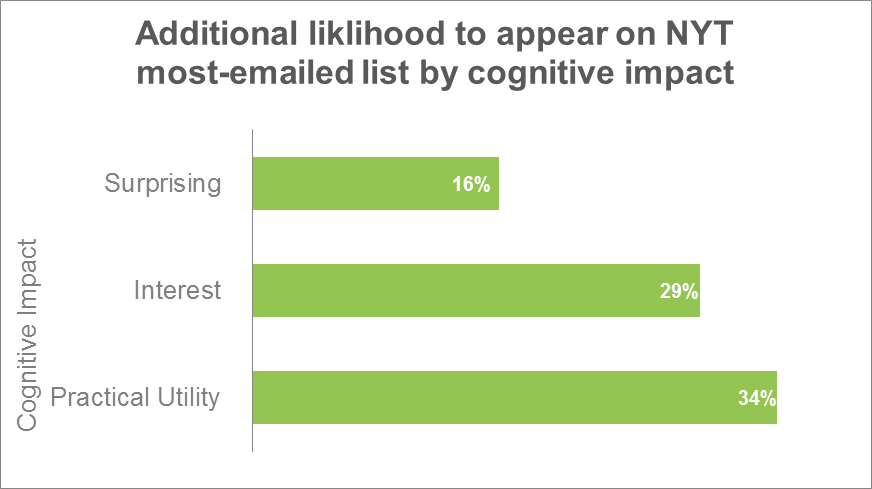
55% of Visitors Read Your Articles For 15 Seconds or Less: Why We Should Focus on Attention Not Clicks
Head of Content at Buffer
Millions of blog posts are published every day.
A small percentage gain traction and attract readers.
And among those readers, 55% will read the blog post for 15 seconds or less.
(If you’re still reading, thanks for sticking with this one!)
The internet is a daily battle for attention. Everywhere you turn, people are trying to share the latest marketing hacks with many of the same points echoed repeatedly.
I’m guilty of it myself, and I completely understand why many of us write articles that are a little similar and repetitive. It’s because they work. You could argue that content is becoming less art and more science. There are formulas to it — if you find the best keywords and write the correct content, you can build a high-traffic blog (that’s almost a guarantee).
But is traffic the goal of content? Or can there be some new and unusual ways of measuring content success? I have some ideas I’d love to share.

Do the surface metrics really matter?
Why pageviews and sessions might be the wrong numbers to chase
Often (and, I’m guilty of this too) you’ll hear someone talk about the success of their content by saying something like: “10,000 people read my post” or “60,000 people saw my video on Facebook.”
But I’ve started to wonder if this is really an accurate measure of successful content?
Even if someone clicks on your article, the likelihood of them taking it all in is very slim. The internet has changed many of our habits. But one thing that hasn’t changed in nearly 20 years is the way we consume content online. Most of us still skim and rarely read a full post.
Many publishers have now started to focus on “attention metrics” alongside more traditional measurements like pageviews. Medium’s Ev Williams explains their stance on which numbers are meaningful:
We pay more attention to time spent reading than number of visitors at Medium because, in a world of infinite content — where there are a million shiny attention-grabbing objects a touch away and notifications coming in constantly — it’s meaningful when someone is actually spending time.
Maybe we need to stop focusing on how we can hack and grow the number of views our content gets. And instead, focus on how we can make each reader care about what we’re saying.
I’d argue that you don’t build a successful blog by accumulating a huge number of page views. Rather, you build a successful blog by creating something of value.
The only way content will drive results for any business is if it provides value to someone else. It’s not necessarily about how many people you reach; it’s how many you connect with. Because when people connect with us, they remember us, come back for more, trust what we have to say, and may eventually buy from us.
When you’re creating great content, you don’t need to live or die by your analytics. Maybe we should let go of our desire to write for everyone in order to skyrocket our pageviews, and instead hone in on sharing what’s unusual, valuable, and unique?

How to measure the value of your content
3 under-used metrics to tell you just how valuable your content is
Value is quite subjective and can be hard to measure. In this section, I’d love to share a few ways we’re starting to measure the value of our content here at Buffer.
1. Run an NPS survey
A Net Promoter Score (NPS) is commonly used to measure loyalty between a brand and a consumer. It can also be a great way to measure the value that your blog is delivering to readers.
You calculate NPS by asking a simple question: How likely is it that you would recommend our blog to a friend or colleague? (Using a 0-10 scale to answer.)
Respondents to the question are then grouped as follows:
- Promoters (score 9-10) are loyal enthusiasts who will keep buying and refer others, fueling growth
- Passives (score 7-8) are satisfied but unenthusiastic customers who are vulnerable to competitive offerings.
- Detractors (score 0-6) are unhappy customers who can damage your brand and impede growth through negative word-of-mouth.
Subtracting the percentage of Detractors from the percentage of Promoters yields the Net Promoter Score, which can range from a low of -100 (if every customer is a Detractor) to a high of 100 (if every customer is a Promoter).
This handy graphic from the Net Promoter Network highlights the formula:

By running an NPS survey on your blog you can begin to understand how many of your readers truly value the content you’re creating and whether they would be happy to share it with their networks.
How to run an NPS Survey
There are plenty of great tools out there to help you run an NPS Survey on your blog and I’d love to share a few below:
- Promotor.io
- SurveyMonkey
- Delighted
- Qualaroo (we use Qualaroo at Buffer)
You can also create your own survey using a tool like Typeform and distribute it to your readers. One thing that feels important to be mindful of is ensuring you reach all kinds of readers with your survey. For example, sending it only to your email subscribers could slightly skew results as they’re likely to already be your most engaged readers.
2. Pay attention to the comments
There has been a lot of debate about the state of blog comments. With the rise of social networks like Twitter, Facebook, and LinkedIn, readers have a multitude of ways to engage with your content:
- They can share a link to your post on Twitter, Facebook (or any network of their choice)
- They can interact with a post where you’ve shared a link back to the blog (favoriting a tweet, sending a reply, liking on Facebook)
- They can retweet your tweet sharing the post or share your Facebook post
- And much, much more…
With all these options and ways to interact with content, you could argue that a blog comment is losing its relevancy — or on the contrary, you could see it that the value of a blog comment is rising.
Knowing that people can share and comment on your post anywhere, the fact they’re taking the time to respond directly within the post itself could be perceived as the highest form of engagement.
For us, comments are an increasingly important metric and one we’re focused on measuring. In Q2 2016, we’ve had a focus on increasing the average comments on each blog post by 100% from Q1 and here’s how we’re getting on:

Comments feel like a great measure of the value your content creates. If someone takes the time to spark a discussion on reply to us through a comment then we feel the post must have been useful to them in some way or sparked some curiosity. A great example is our recent social media study post. This one generated over 70 comments with readers sharing their thoughts on the study and also how our findings compare to their own.
3. Monitor mentions and shares
Whenever I publish a post on the Buffer blog, I’ll get a few mentions on Twitter or LinkedIn when people share it. As a result of this, I’ve started to build a slight intuition around how much value each post is generating based on shares and mentions.
When a post really delivers value and goes above and beyond reader expectations, I’ll notice a distinct spike in the number of shares it receives and the number of mentions we receive both via the @buffer accounts and my own personal social media accounts.
It’s super easy to keep tabs on how many times your content has been shared. Sharing plugins like SumoMe and Social Warfare can provide share counts on your posts and PostReach (full disclosure: this is a tool a few friends and I have built) and Buzzsumo can pull in data about who is sharing each of your posts on Twitter. I also like to pay extra close attention to my mentions on Twitter after a new post goes live so I can gauge how it’s doing and see what people are saying.
A quick tip: Promise value in your headline
Headlines are amazingly important to the success of a piece of content. Before we publish a post, we spend a bit of time focusing on how we can craft a headline that gives the content the best chance of being seen. Amazing content behind a weak headline probably won’t get seen.
Sometimes we’ll create between 20-30 headlines for each post and choose the one that feels best and other times we’ll have a quick chat and riff on how we can make the headline stand out. Here are some extracts from a recent conversation between Leo and I:

The original headline we had was:
53 Graphic Design Terms and Definitions for Non-Designers
And the title we decided on when we hit publish is:
Why Every Marketer in 2016 Needs to Be a (Part-Time) Designer: 53 Design Terms and Tips to Level-Up
This post has generated plenty of shares so far and 18 comments (at the time of writing). By focusing on the headline, we were able to promise value: 53 Design Terms and Tips to Level-Up. And also spark a discussion about the role of a marketer: Why Every Marketer in 2016 Needs to Be a (Part-Time) Designer. Without the time spent tweaking this headline, I’m not sure we would have had such success with this post.

What makes an idea worth writing about?
Every blog post begins as an idea, but what makes an idea stand out and how do you know which ideas to act on and publish?
Before choosing a post to write, I tend to ask myself three questions:
- Is this actionable?
- Who will amplify this?
- What makes it unique?
And I’d love to go into detail on each of the three questions below:
1. Is it actionable?
On the Buffer blog, we strive to deliver content that helps readers solve a problem or challenge they face in their every-day work environment. This means we like them to be able to read a post and directly action something they’ve learned from it.
We focus on making content actionable because we believe that if someone learns something from one of our posts they’re likely to remember us and even share the post with their network as a New York Times study found that content that is practically useful gets shared more than any other content:

2. Who will amplify it?
When creating content, it’s important to hone in on your audience and think about who you’re writing for. One way I like to frame this is to ask myself “who will amplify this post?” If I can’t answer this question then I won’t write the post. Normally, this question forces me to focus on a specific area of marketing or a specific role.
(h/t to Rand Fishkin for this one)
3. What makes it unique?
We’re surrounded by content nowadays and if you want to stand out, you need to craft content that’s unique.
What makes a piece of content unique can vary from post to post. Sometimes it can be timing that makes a post unique, for example, when we published our post on Twitter Polls it was launched shorty after Polls were publicly announced and was one of the first guides on how to use the feature.
Other ways to make your content unique include:
- Sharing your unique perspective: One of the best ways to make a piece of content unique is to create something that only you can by adding in your own perspective and point of view. As Jory McKay explains on the Crew blog: “Everything has been said before, but it’s never been said by you.”
- Going deeper on a topic that anyone else: There might be a ton of posts out there about Facebook Ads, for example, but you can create a unique post on this subject by going more in-depth than anyone else has.

Over to you
I believe we can create more value if we pay closer attention to depth than breadth. It’s not so much how many people click on our content, it’s how many people pay attention to our content. It’s how many people we can make an impression on and connect with that really matters.
Measuring the success of blog content is an interesting topic and I’d love to hear your thoughts on the subject.
Do you feel we put too much focus on the metrics like page views and sessions? How do you measure the quality and value provided by a blog post? I’d love to hear your thoughts in the comments below.
Try Buffer for free
140,000+ small businesses like yours use Buffer to build their brand on social media every month
Get started nowRelated Articles

Sending ads by mail may seem like a thing of the past, but this marketer thinks it’s a surprisingly effective approach for e-commerce brands.

Learn how to leverage AI social media content creation tools and save valuable time in your social media marketing efforts.

With the newsletters on this list, you'll be able to stay on top of all developments in social media and learn from amazing experts